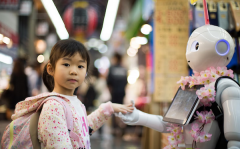Katherine Davidson is a PhD candidate in the Department of Sociology and Anthropology

We are preparing to welcome our new robot overlords. Photo: Andy Kelly, via Unsplash
The AI debate is upon us in full swing; Getty Images is suing Stability AI over digital image copyright (Vincent 2023), OpenAI and others are releasing tools to help detect AI-written text (of particular interest to educators in the fight for academic integrity; OpenAI 2023), and YouTubers everywhere are playing with ChatGPT to write creative content for their channels.
Yes, the craze and panic is ubiquitous, but sometimes I wonder why it feels strangely – empty?
I think part of this emptiness comes from the medium of AI, which has been largely visual, being that it is a computer-mediated process. Contemporary society places a huge emphasis on the visual, something that Levin calls the visual hegemony of modernity (Levin 1993). Similarly, in his chapter Materials Against Materiality, Ingold describes that materials have an “active power” of agency outside of their forms as objects, a factor which is missing (or at least different) from digital media (Ingold 2014: 28).
As Pereira and Moreschi state, AI reflects the thing (an image, a piece of text), but without context (Pereira and Moreschi 2021: 1202). Because AI is fed visual media, it can conceive of visual media enough to replicate it – the content of a piece of digital art, or a photo. But as Pereira and Moreschi observed, it starts going weird when you give it a photo of a framed piece of art on a wall. It gets even weirder when the art is 3D, as with sculpture and abstract art.
I love art, especially functional art. My mom is a potter, and in the decades that I have watched her and our friends in the Ottawa Guild of Potters work, I have seen the importance of different aspects of touch related to ceramic art. The texture, weight and porosity of different types of clay shaped by hand or wheel in such diverse ways ensures that every vessel is a unique experience. Those experiences have meaning, to the extent that I have a favourite mug for coffee (it just tastes better in that mug!), or bowl for soup, or cup for beer. The connection elicited through that artistry and experience is part of why even world-renowned restaurants like Noma use handmade ceramics in their services.

No two vessels are created equal. Photo Katja Vogt via unsplash.com
Similarly, I am an archaeologist – material culture from the past is what I study. Like my mom and the vast network of ceramic artists around the world, touch is a main sense for archaeologists too. Touch gives us information about the materials used to make an artifact; touch allows us to ascertain the quality of a tool or how much it was used (for example, how sharp is a lithic edge, how thin are the walls of a vessel). A big part of my ongoing thesis research investigates this multisensorily-mediated connection with archaeological objects that occurs with artifact handling.
We have seen in the Xlab that GANs can understand the general makeup of what a photo of a skull or a photo of red- or black-figure pottery looks like, specifically in museum collections (especially that these neural networks know that those photos always have a scale in them). It is interesting to watch a GAN negotiate the visual specifics of how it imagines artifacts, but it is glaringly obvious that a big part of the meaning that objects have is omitted when it has no material component to relate to living things.
In thinking about AI’s lack of materiality – or, rather, lack of a sense of relationality to the living world – my point is that AI is not the be-all and end-all of creativity or of acting into the world. In fact, it is a dim reflection at best (students, keep this in mind when you are tempted to use gpt-3 for essay writing). There are a lot of things that AI can’t do, and those things have meaning – we miss them when they aren’t there. Until AI begins to bridge that gap to encompass other senses, or other significant meanings, it will continue to feel empty.
References:
Ingold, Tim. 2011. Being Alive: Essays on Movement, Knowledge and Description. London, UNITED KINGDOM: Routledge. http://ebookcentral.proquest.com/lib/oculcarleton-ebooks/detail.action?docID=684030.
Levin, David Michael. 1993. Modernity and the Hegemony of Vision.
OpenAI. “New AI Classifier for Indicating AI-Written Text.” 2023. January 31, 2023. https://openai.com/blog/new-ai-classifier-for-indicating-ai-written-text/.
Pereira, Gabriel, and Bruno Moreschi. 2021. “Artificial Intelligence and Institutional Critique 2.0: Unexpected Ways of Seeing with Computer Vision.” AI & SOCIETY 36 (4): 1201–1223.
Vincent, James. 2023. “Getty Images Is Suing the Creators of AI Art Tool Stable Diffusion for Scraping Its Content.” The Verge. January 17, 2023. https://www.theverge.com/2023/1/17/23558516/ai-art-copyright-stable-diffusion-getty-images-lawsuit.